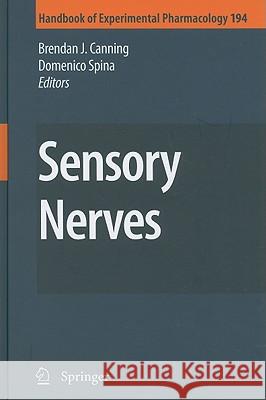Sensory Nerves » książka
Sensory Nerves
ISBN-13: 9783540790891 / Angielski / Twarda / 2009 / 640 str.
Theintentionofthisbookistoprovideacomprehensiveandcontemporaryreview ofthebiologyofsensorynerves. InkeepingwiththethemeoftheHandbookof Experimental Pharmacology series, emphasis will be placed on the actions of drugs, transmittersandautacoidsthatinitiateorinhibitsensorynerveactivation (through actionsonionchannelsandreceptorsattheirperipheralterminals)or modulate the release or actions of the transmitters released from the central terminalsofsensorynerves. Onthebasisofextensivesupportiveevidenceinthe literature, it is our view that many diseases are characterized by alterations in sensorynervefunction(e. g. pain, cardiovasculardiseaseandmigraine). Itisour beliefthatthisbookwillbeunique, asitwillcomprehensivelycovertheroleof sensory nerves across many therapeutic areas. To address directly one of the editorialboardqueries, thisisnotintendedtobeabookaboutthepharmacology ofpain. Thatsaid, tomostpharmacologists, painisthemostobviousindicationfor aroleorsensorynervesindisease. Webelievethatthelessonslearntfromthestudy ofneuropathicpainwillbeinvaluableforresearchersintheothertherapeuticareas covered inthisvolume. Sincemostinterest hasfocusedontheroleofsensory nervesinneuropathicpain, wehaveaddedanumberofchaptersdevotedtothis subject. Thebookisorganizedinthreeparts, coveringthetypesandrolesofsensory nervesinsomaticandvisceraldisorders(PartI), speci?ctargetsonsensorynerves relevanttopainandvisceraldisorders(PartII)andadescriptionofcurrentand futuretherapeuticstrategiesfortargetingsensorynerves(PartIII). The?rsttwochaptersinPartIaredevotedtodescribingtheclinicalfeaturesof neuropathicpainandvisceralpain. Ourintentionisfortheauthorstoprovidea clinicalviewpointonthefeaturesoftheseconditionsandtheadvantages/disadv- tagesofcurrenttreatmentmodalities. Thenext?vechaptersinPartIfocusonthe roleofsensorynervesinotherpathologicalconditions. Severalcommonthemes willemergeinthispart, includingthemodeofsensorynerveactivationinvarious tissues and organs, the alterations in sensory nerve excitability associated with disease, andtheimportanceofin?ammationandin?ammatorymediatorsininiti- ingalteredsensorynervefunctionindisease. v vi Preface Whilstthe?rstpartfocusesontheclinicaland/orsystemsphysiology, PartIIhas itsfocusatthecellandmolecularlevel. Thisparthighlightsthecurrentundersta- ingofproteins/ionchannels/mediatorsthathavecreatedthemostintenserecent interestintheareaofsensorynervebiology. Together, thesechapterswillgivethe reader important knowledge about how sensory nerve function can be altered pharmacologically. Thelastchapterinthispartdescribestheprocessesthatgive risetoalteredneuralre?exesatthecentrallevel. Themechanismsdescribedin thesechaptersreinforcetheroleofproteins/mediatorshighlightedinthepreceding chapters. Theroleofthesecellular, molecularandphysiologicalprocessesinthe diseasesdiscussedinPart1areemphasized. TheaimofPartIIIistohighlightpotentialdrugtargetsthatmightaltersensory nervefunction. Mostoftheworkhasbeendevotedtothetreatmentofneuropathic painandsothispartheavilyemphasizesthissubject. However, aswillbeapparent fromPartI, manyofthesetargetscouldbeutilizedinothertherapeuticareasthat implicatesensorynervesintheirpathophysiologicalprocesses. Thefocusofthe chaptersisonopioidsandmodulatorsofionchannelsandthenthe?nalchapteris devotedtofuturetreatmentstrategiesforneuropathicpain. Finally, wewouldliketothankallthecontributors, includingco-authors, who agreedtowritechaptersforthisbookandthepublishers, especiallySusanneDathe, fortheirpatienceandassistance. Baltimore B. J. Canning London D. Spina Contents PartI RoleofSensoryNervesinDisease NeuropathicPain: AClinicalPerspective . . . . . . . . . . . . . . . . . . . . . . . . . . . . . . . . . . . . . 3 RalfBaron VisceralPain: TheNeurophysiologicalMechanism. . . . . . . . . . . . . . . . . . . . . . . . . . 31 JyotiN. Sengupta Migraine . . . . . . . . . . . . . . . . . . . . . . . . . . . . . . . . . . . . . . . . . . . . . . . . . . . . . . . . . . . . . . . . . . . . . . . . . 75 SilviaBenemei, PaolaNicoletti, JayG. Capone, Francesco DeCesaris, andPierangeloGeppetti AfferentNerveRegulationofBladderFunctioninHealth andDisease . . . . . . . . . . . . . . . . . . . . . . . . . . . . . . . . . . . . . . . . . . . . . . . . . . . . . . . . . . . . . . . . . . . . . . 91 WilliamC. deGroatandNaokiYoshimura SensoryNervesandAirwayIrritability. . . . . . . . . . . . . . . . . . . . . . . . . . . . . . . . . . . . . 139 B. J. CanningandD. Spina RegulationofCardiacAfferentExcitabilityinIschemia. . . . . . . . . . . . . . . . . . 185 Liang-WuFuandJohnC. Longhurst RolesofGastro-oesophagealAfferentsintheMechanisms andSymptomsofRe?uxDisease . . . . . . . . . . . . . . . . . . . . . . . . . . . . . . . . . . . . . . . . . . . . 227 AmandaJ. PageandL. AshleyBlackshaw PartII CellandMolecularMechanismsRegulatingSensory NerveFunction TransientReceptorPotentialChannelsonSensoryNerves . . . . . . . . . . . . . . . 261 S. R. EidandD. N. Cortright Acid-SensitiveIonChannelsandReceptors . . . . . . . . . . . . . . . . . . . . . . . . . . . . . . . . 283 PeterHolzer PurinesandSensoryNerves. . . . . . . . . . . . . . . . . . . . . . . . . . . . . . . . . . . . . . . . . . . . . . . . . . 333 GeoffreyBurnstock vii viii Contents Sensory-Nerve-DerivedNeuropeptides: PossibleTherapeuticTargets . . . . . . . . . . . . . . . . . . . . . . . . . . . . . . . . . . . . . . . . . . . . . . . . 393 ElizabethS. Fernandes, SabineM. SchmidhuberandSusanD. Brain CytokineandChemokineRegulationofSensory NeuronFunction . . . . . . . . . . . . . . . . . . . . . . . . . . . . . . . . . . . . . . . . . . . . . . . . . . . . . . . . . . . . . . 417 RichardJ. Miller, HosungJung, SoniaK. BhangooandFletcherA. White TheRoleofPeptidesinCentralSensitization . . . . . . . . . . . . . . . . . . . . . . . . . . . . . . 451 V. S. Seybold PartIII CurrentandFutureTreatmentStrategiesTargeting SensoryNerves OpioidsandSensoryNerves . . . . . . . . . . . . . . . . . . . . . . . . . . . . . . . . . . . . . . . . . . . . .











